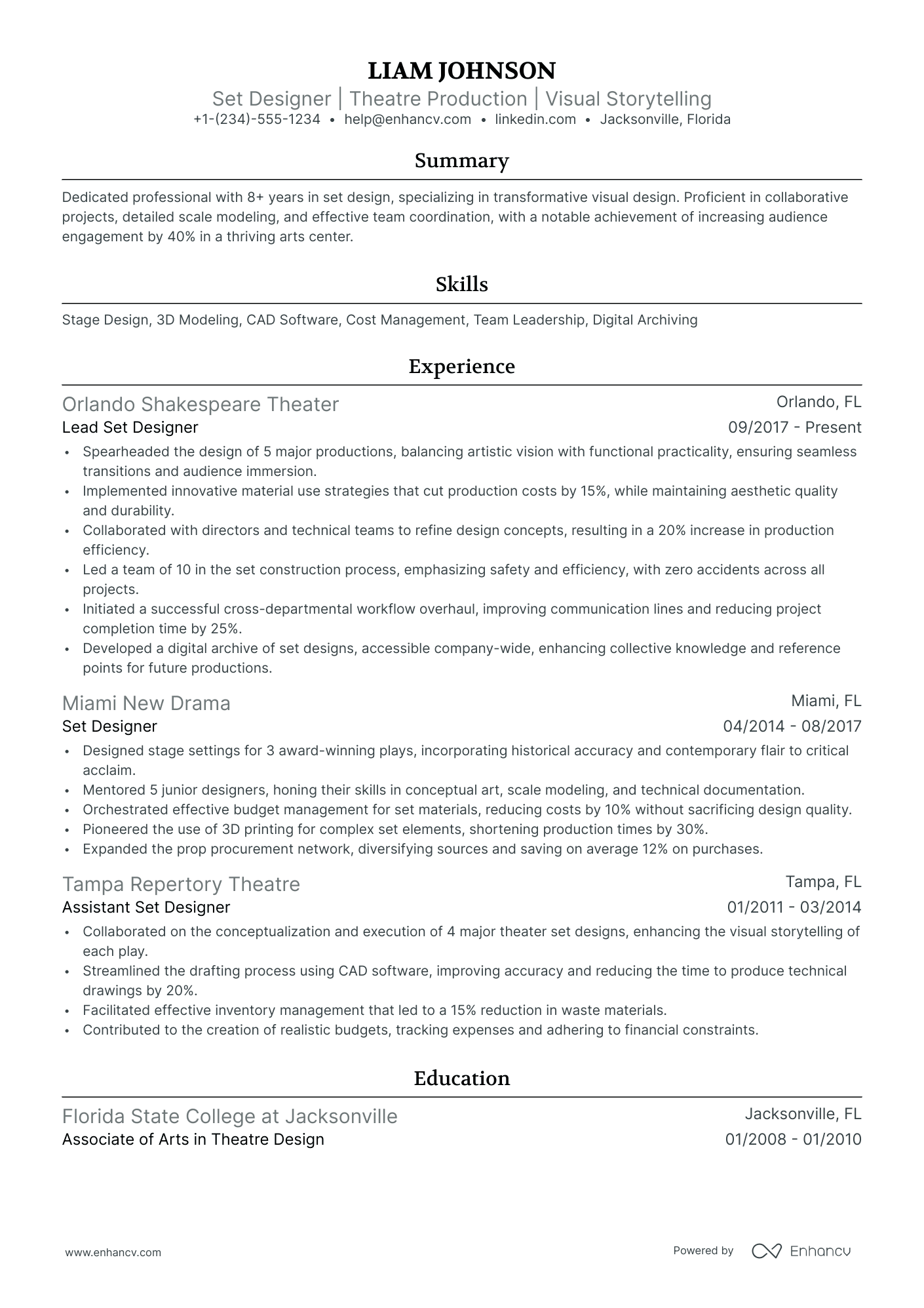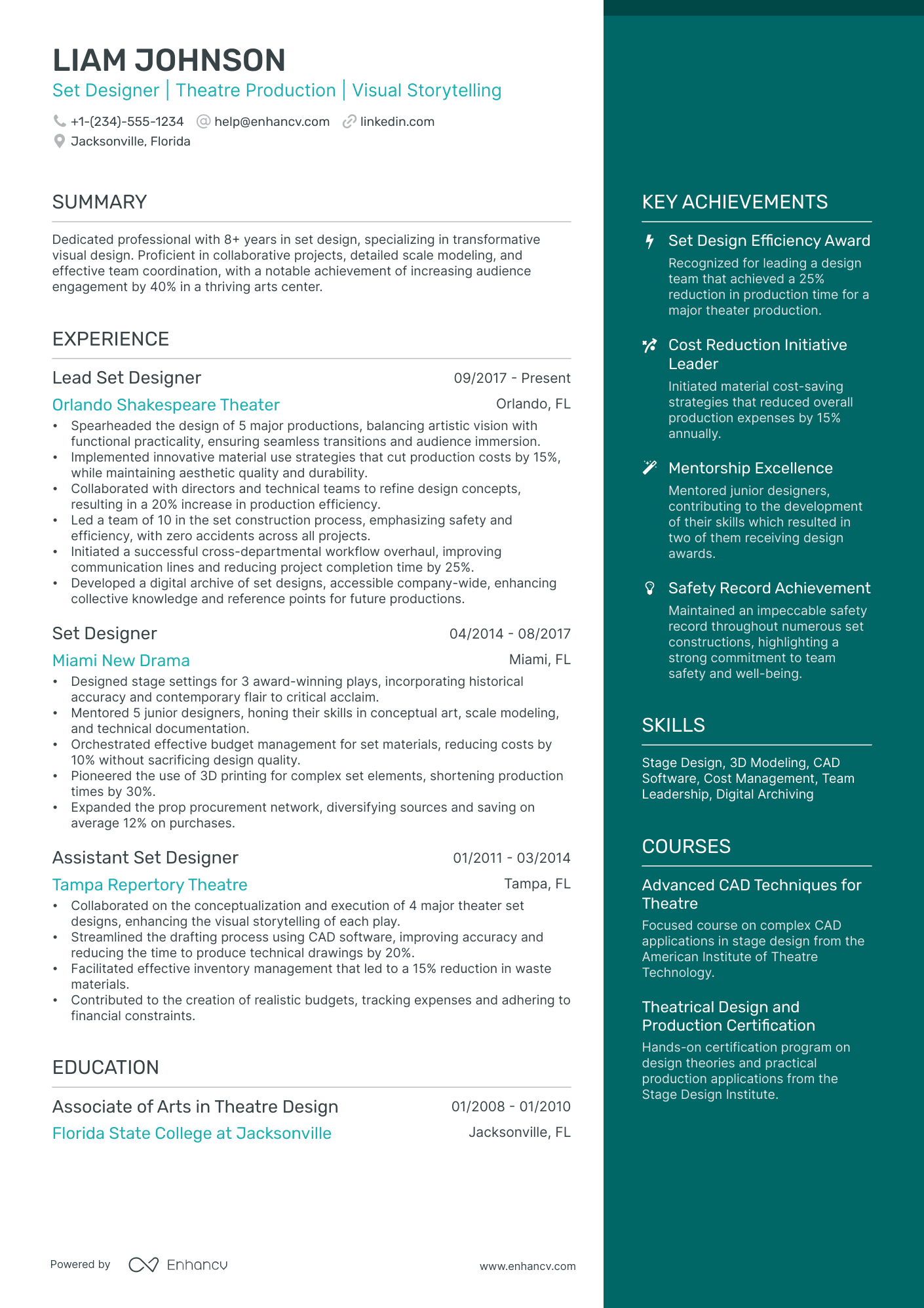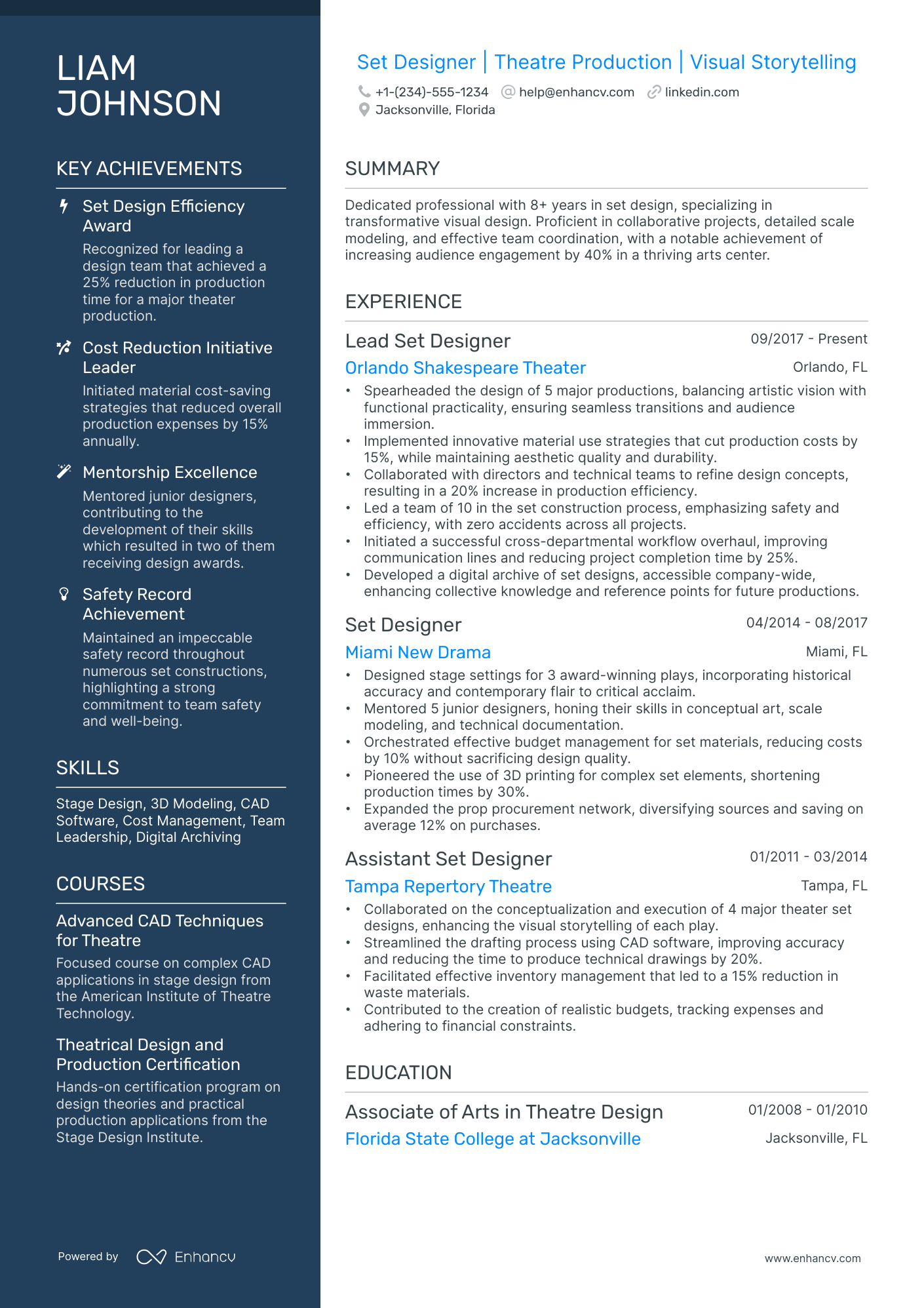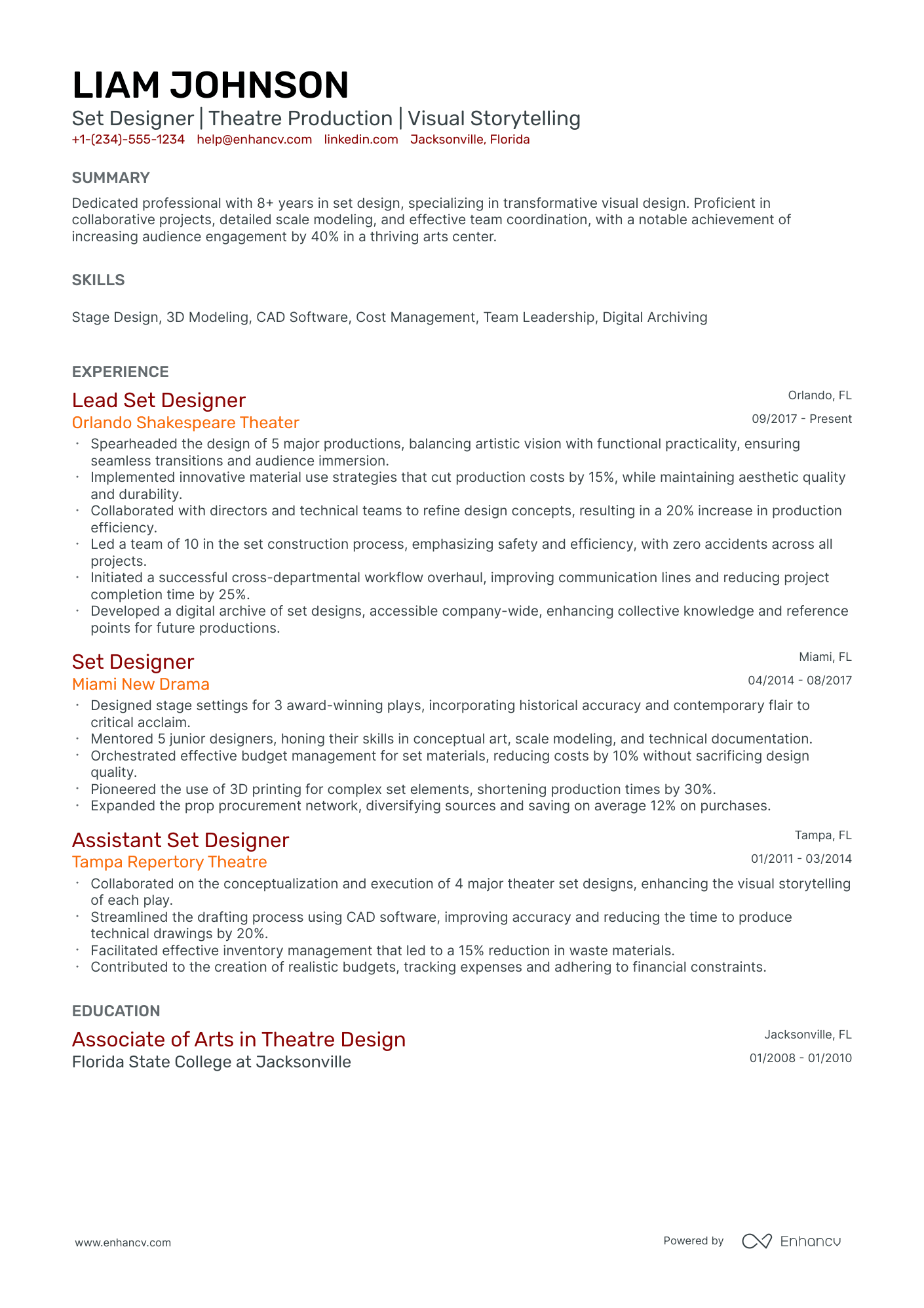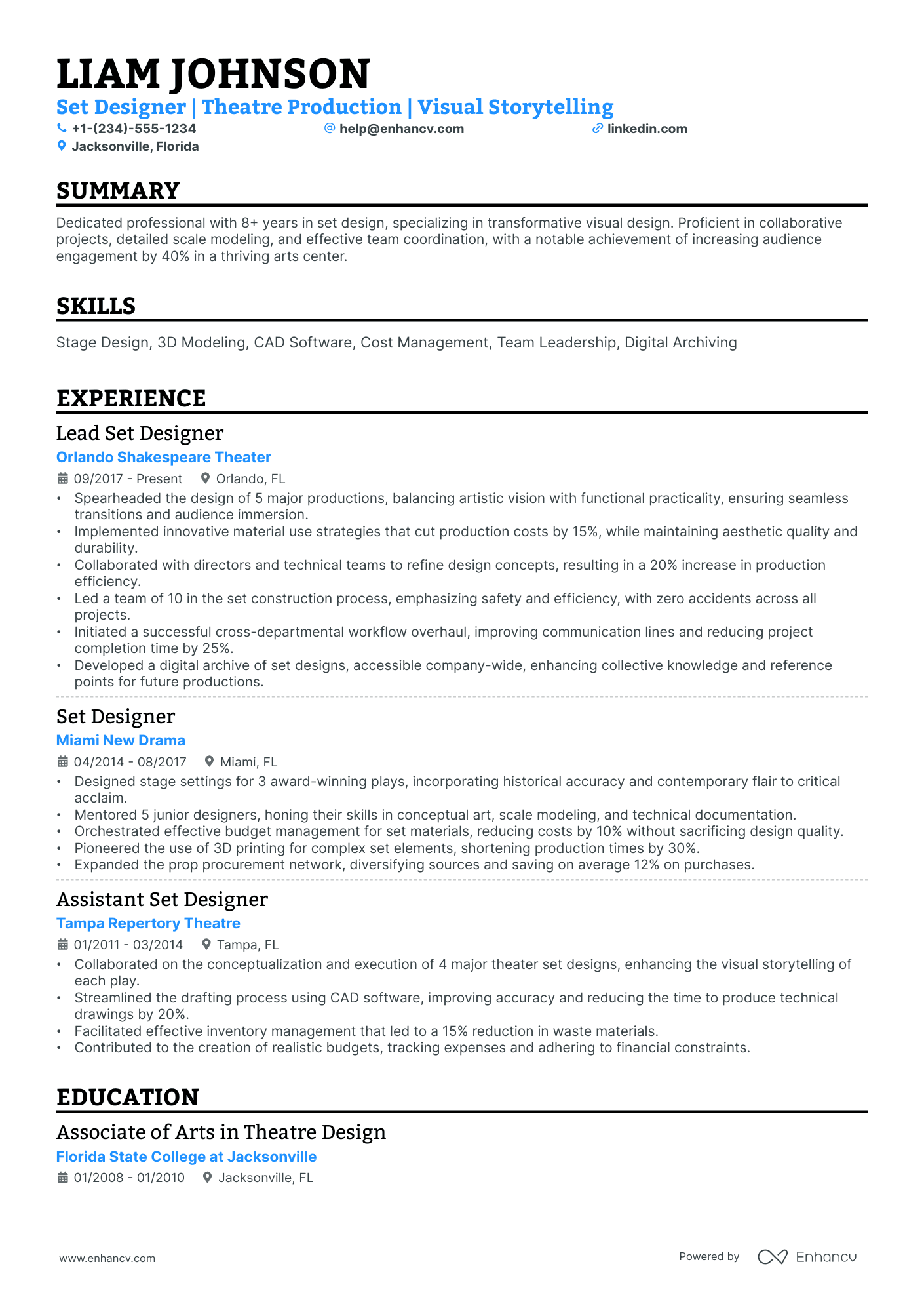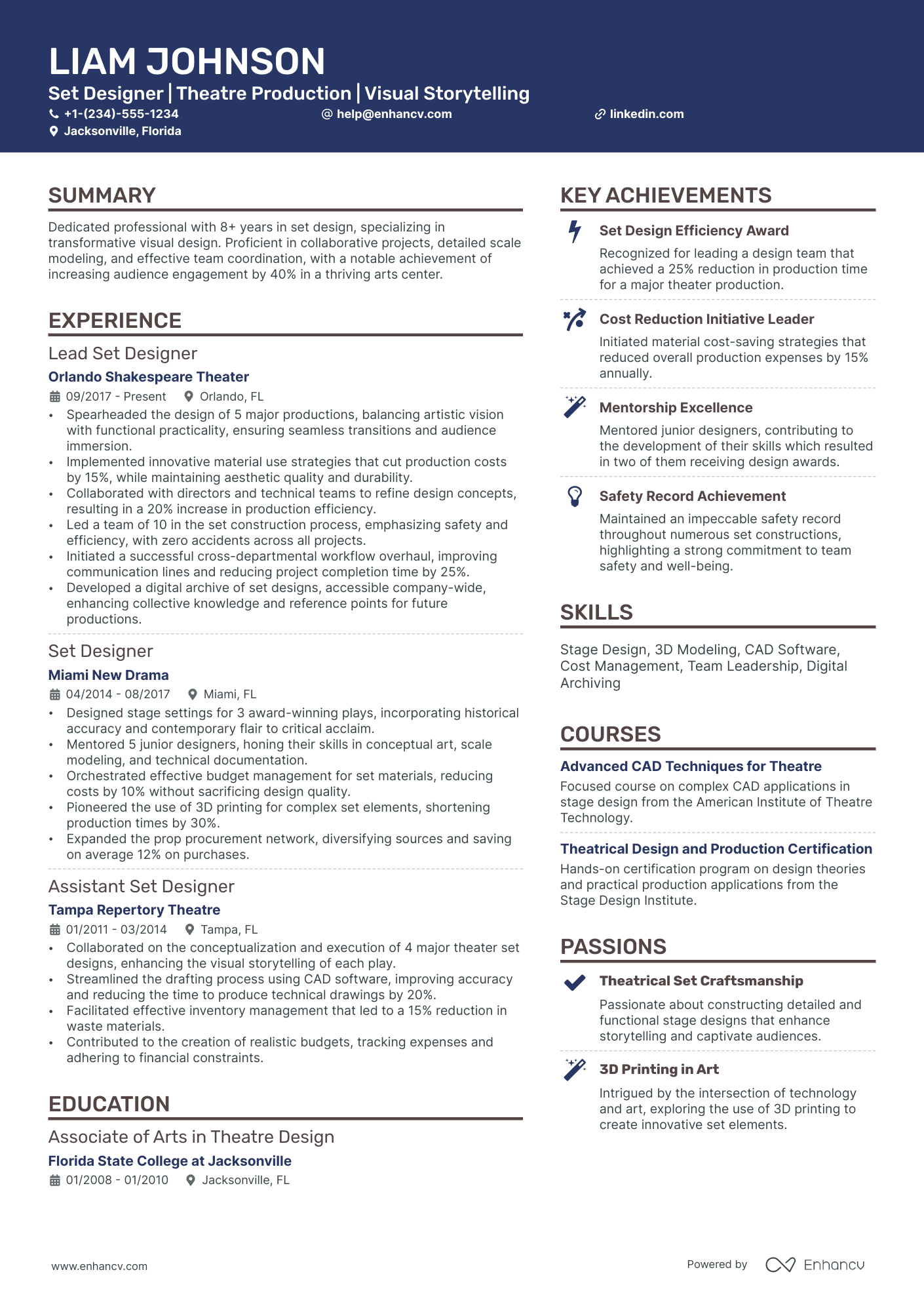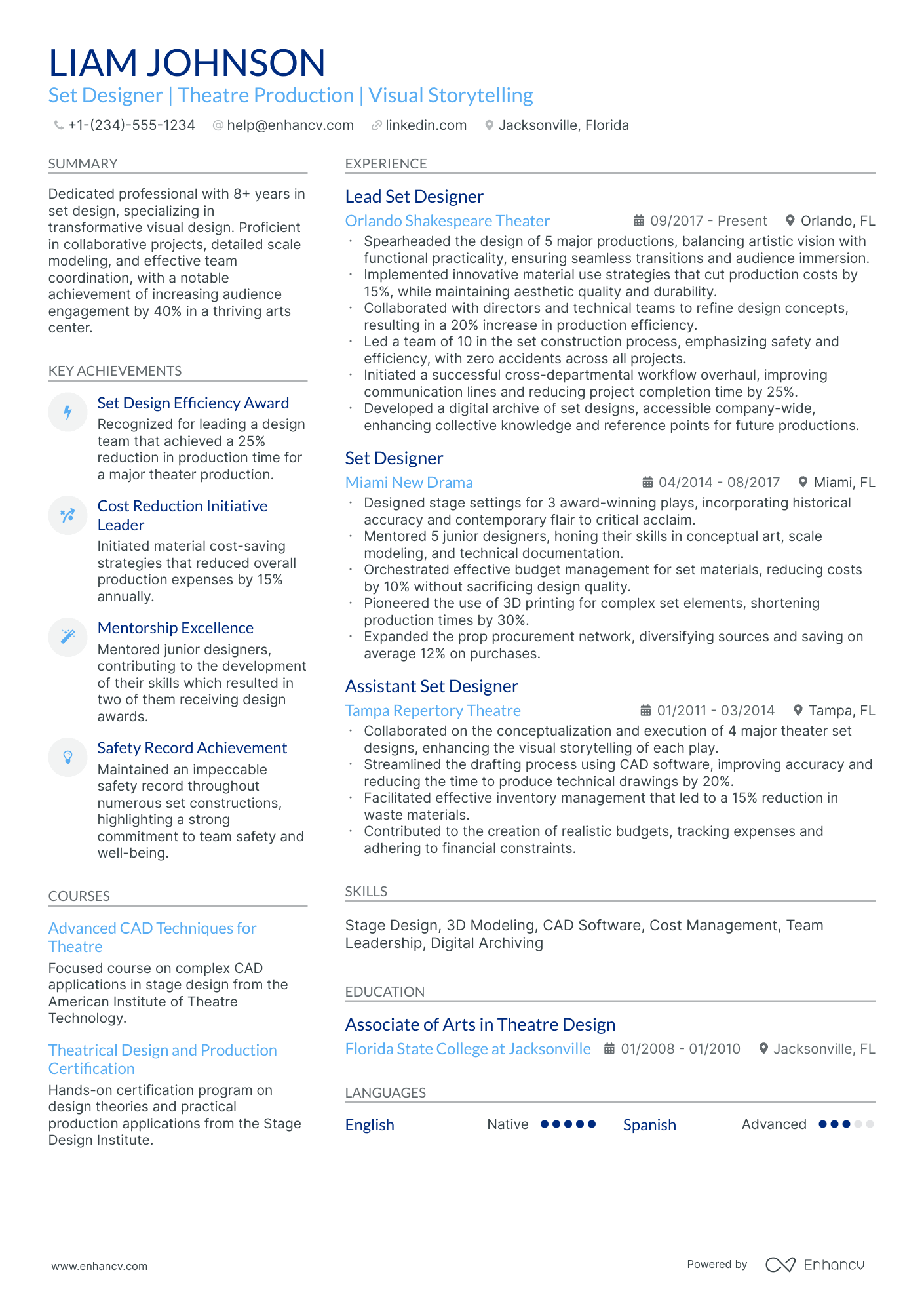As a set designer, one resume challenge you may face is effectively translating your visual and spatial design skills into compelling text that captures your creativity and eye for detail. Our guide can help you articulate your unique design accomplishments and project experiences, ensuring potential employers grasp the full scope of your talents and contributions to previous productions.
- Aligning the top one-third of your set designer resume with the role you're applying for.
- Curating your specific set designer experience to get the attention of recruiters.
- How to list your relevant education to impress hiring managers recruiting for the set designer role.
Discover more set designer professional examples to help you write a job-winning resume.
Creating the best set designer resume format: four simple steps
The most appropriate set designer resume format is defined by precision and a systematic approach. What is more, it should reflect upon how your application will be assessed by recruiters. That is why we've gathered four of the most vital elements to keep in mind when designing your resume:
- It's all about presenting how your experience or skills align with the job. Use the reverse-chronological resume format , if your expertise is relevant to the set designer role. Otherwise, select the functional skill-based resume format or the hybrid resume format to shift the focus to your skill set.
- Resume header - make sure you've filled out all relevant (and correct) information, like your contact details and link to your portfolio.
- Resume length - unless you've over a decade of applicable expertise in the field, stick with a one-page resume format. If you'd like to present more of your professional experience, go up to two pages.
- Resume file - submit your set designer resume in a PDF format to ensure all information stays in the same place.
Adjust your resume layout based on the market – Canadian resumes, for example, may follow a unique format.
Upload & Check Your Resume
Drop your resume here or choose a file. PDF & DOCX only. Max 2MB file size.
PRO TIP
If you're in the process of obtaining your certificate or degree, list the expected date you're supposed to graduate or be certified.
Traditional sections, appreciated by recruiters, for your set designer resume:
- Clear and concise header with relevant links and contact details
- Summary or objective with precise snapshot of our career highlights and why you're a suitable candidate for the set designer role
- Experience that goes into the nuts and bolts of your professional qualifications and success
- Skills section(-s) for more in-depth talent-alignment between job keywords and your own profile
- Education and certifications sections to further show your commitment for growth in the specific niche
What recruiters want to see on your resume:
- Demonstrated ability to interpret scripts and conceptualize visual elements that reflect the story's mood and era.
- Portfolio showcasing previous set designs and an understanding of space, color theory, and architectural styles.
- Proficiency in CAD software and other design tools such as SketchUp, Vectorworks, or AutoCAD for creating precise and technical drawings.
- Practical knowledge of set construction, materials, and budget management to ensure feasible and cost-effective designs.
- Experience collaborating with directors, costume designers, lighting technicians, and other departments to create a cohesive aesthetic for productions.
Five dos for building your set designer resume experience section
The best strategic approach to your set designer resume experience section is to support your particular responsibilities with actions and achievements.
For example, you could list:
- Up to six responsibilities in your day-to-day work, supported by why they're important for your role, department, or organization;
- Experience items that have helped you sustain and enhance your technical knowledge within the field, or, perhaps, have helped you grow as a professional;
- Any metrics that pinpoint your success within your past roles;
- How you've solved specific problems in your day-to-day work;
- Strategies and solutions you've implemented for growth - and how that growth was measured.
The set designer resume experience is your best shot at making a good first impression on recruiters. That's why we've included some real-world professional examples to get you thinking about how you present your experience:
- Lead a team of 5 junior designers in developing and executing innovative set designs for over 20 live theater productions, achieving critical acclaim and an average 95% attendance rate.
- Implemented a sustainable design strategy that reduced overall set construction waste by 30%, aligning with the company’s commitment to environmental responsibility.
- Spearheaded the transition to digital rendering technologies, streamlining the design workflow and cutting development time by 25% for faster project turnarounds.
- Oversaw the end-to-end set design processes for 12 major television shows, including concept development, sketches, models, and final construction documentation.
- Developed a catalog of reusable set pieces that lowered production costs by 15% while maintaining aesthetic variety across different shows.
- Cultivated partnerships with local artists to incorporate original artworks into sets, enhancing visual storytelling and garnering positive media attention.
- Managed set design for a blockbuster film with a $150 million budget, ensuring visual consistency and alignment with the director’s vision.
- Designed and directed the construction of a full-scale replica of a historical landmark, which became a temporary museum exhibit after filming, drawing over 50,000 visitors.
- Introduced a real-time 3D visualization tool, enhancing collaboration between directors, producers, and the design team.
- Directing the creative vision for set designs across all stage productions for a prestigious regional theater, managing a budget of $5 million annually.
- Launched an apprenticeship program that trains 10 aspiring set designers each year, contributing to the professional growth of the industry.
- Collaborated with international directors on cross-cultural productions, increasing the theater's visibility in the global market by 20%.
- Participated in the creation of memorable set designs for 5 award-winning independent films, with meticulous attention to historical accuracy and detail.
- Coordinated with production teams to manage on-location set constructions, ensuring seamless integration of natural and artificial elements.
- Developed a digital asset library for set pieces, which improved design efficiency and facilitated remote collaboration.
- Directed the set design team for a hit TV series, which saw a viewership increment of 40% over two seasons due to its visually compelling backdrops.
- Negotiated with vendors for material procurement, achieving a cost reduction of 20% while maintaining high-quality standards.
- Implemented an internal review and mentoring system, resulting in a 35% improvement in design team efficiency and cohesiveness.
- Coordinated with directors and production managers to ensure that set designs were produced on time, within a budget, for 10+ stage productions.
- Improved cross-department communication, which facilitated faster problem-solving and adherence to tight schedules.
- Maintained an extensive inventory of set materials, enabling a quick turnaround for unexpected design changes and last-minute requests.
- Designed and implemented engaging sets for various clients, including local theaters, schools, and corporate events, tailoring each project to specific themes and budgets.
- Navigated through diverse design challenges and client requirements to deliver creative solutions that enhanced audience engagement across 30+ projects.
- Leveraged social media platforms to display portfolio, leading to a 50% increase in client base over a 16-month period.
The following content includes information from "O*NET OnLine" by the U.S. Department of Labor, Employment and Training Administration (USDOL/ETA). Used under the CC BY 4.0 license. The data represents the top responsibilities present on the task lists for set designer professionals.
Top Responsibilities for Set Designer:
- Develop set designs, based on evaluation of scripts, budgets, research information, and available locations.
- Prepare rough drafts and scale working drawings of sets, including floor plans, scenery, and properties to be constructed.
- Prepare preliminary renderings of proposed exhibits, including detailed construction, layout, and material specifications, and diagrams relating to aspects such as special effects or lighting.
- Read scripts to determine location, set, and design requirements.
- Submit plans for approval, and adapt plans to serve intended purposes, or to conform to budget or fabrication restrictions.
- Attend rehearsals and production meetings to obtain and share information related to sets.
- Confer with clients and staff to gather information about exhibit space, proposed themes and content, timelines, budgets, materials, or promotion requirements.
- Research architectural and stylistic elements appropriate to the time period to be depicted, consulting experts for information, as necessary.
- Observe sets during rehearsals in order to ensure that set elements do not interfere with performance aspects such as cast movement and camera angles.
- Collaborate with those in charge of lighting and sound so that those production aspects can be coordinated with set designs or exhibit layouts.
Quantifying impact on your resume
- Quantify the size of the venues for which you've designed sets to demonstrate your experience with different scales of production.
- Include the number of set designs you have successfully completed to show your level of expertise and work rate.
- List the budgets you have managed for set designs to indicate your financial responsibility and resource management skills.
- Mention the diverse range of productions you've worked on by providing a count of genres or types to highlight your versatility.
- Specify the number of design awards or recognitions received to establish credibility and a history of success.
- Detail the percentage of projects completed by or under the deadline to showcase your time management and efficiency.
- Document the number of team members you've supervised or collaborated with to reflect your teamwork and leadership abilities.
- Record the increase in audience or ticket sales for performances featuring your set designs to correlate your work with business success.
Action verbs for your set designer resume
Experience section for candidates with zero-to-none experience
While you may have less professional experience in the field, that doesn't mean you should leave this section of your resume empty or blank.
Consider these four strategies on how to substitute the lack of experience with:
- Volunteer roles - as part of the community, you've probably gained valuable people (and sometimes even technological capabilities) that could answer the job requirements
- Research projects - while in your university days, you may have been part of some cutting-edge project to benefit the field. Curate this within your experience section as a substitute for real-world experience
- Internships - while you may consider that that summer internship in New York was solely mandatory to your degree, make sure to include it as part of your experience, if it's relevant to the role
- Irrelevant previous jobs - instead of detailing the technologies you've learned, think about the transferable skills you've gained.
Recommended reads:
PRO TIP
Mention specific courses or projects that are pertinent to the job you're applying for.
Set designer resume skills: the essential hard skills and soft skills checklist
Ultimately, your set designer resume should hint to recruiters that you possess an array of talents that are indispensable to the role.
For example, listing the technologies and software you're apt at using (or your hard skills) and how you apply them in your day-to-day responsibilities would ensure you meet the technical requirements of the role.
But is this enough to ensure that you make a good impression on recruiters?
Go a step further by detailing the soft skills or personality traits you've attained thanks to your work and life experience.
The best way to balance hard skills and soft skills on your set designer resume is by:
- Highlighting up to three of your most noteworthy career accomplishments in a separate section.
- Listing at least one hard skill and one soft skill you've used to solve a particular challenge or problem.
- Feature niche skills and technologies that would help you stand out amongst candidates.
- Think back on the social impact your efforts have had towards improving the work environment - were you able to always maintain a professional ethic, while enhancing the team culture? Write about your contribution to the role, department, or organization itself as a metric of success.
The skills section of your resume provides you with plenty of opportunities to detail your technical and personal traits.
All you have to do is select the talents that best fit your application and expertise. Make note of some of the most prominent hard and soft skills across the industry from our list:
Top skills for your set designer resume:
AutoCAD
SketchUp
Adobe Creative Suite
3D Modeling Software
Scene Painting Techniques
Set Construction
Lighting Design
Prop Fabrication
Stage Management Software
Drafting Techniques
Creativity
Collaboration
Attention to Detail
Problem Solving
Time Management
Communication
Adaptability
Critical Thinking
Project Management
Vision
Next, you will find information on the top technologies for set designer professonals from "O*NET OnLine" by the U.S. Department of Labor, Employment and Training Administration (USDOL/ETA). Used under the CC BY 4.0 license.
Top technologies for Set Designer’s resume:
- Autodesk Revit
- Trimble SketchUp Pro
- Microsoft PowerPoint
- Adobe Creative Cloud software
- Adobe Illustrator
PRO TIP
The more trusted the organization you've attained your certificate (or degree) from, the more credible your skill set would be.
Listing your education and certifications on your set designer resume
Don't underestimate the importance of your resume education section . As it may hint at various skills (and experience) that are relevant to the job. When writing your education section:
- Include only higher education degrees with information about the institution and start/end dates
- If you're in the process of obtaining your degree, include your expected graduation date
- Consider leaving off degrees that aren't relevant to the job or industry
- Write a description of your education if it presents you with an opportunity to further showcase your achievements in a more research-focused environment
When describing your certifications on your resume, always consider their relevancy to the role. Use the same format to describe them as you would for your education. If you're wondering what the best certificates out there are for set designer roles, check out the list below.
The top 5 certifications for your set designer resume:
- Certified Scenic Artist (CSA) - United States Institute for Theatre Technology (USITT)
- AutoCAD Certification (AC) - Autodesk
- Certified Vectorworks Professional (CVP) - Vectorworks, Inc.
- Adobe Certified Expert (ACE) - Adobe Systems
- Entertainment Technician Certification Program (ETCP) - Entertainment Services and Technology Association (ESTA)
The content below includes information from "O*NET OnLine" by the U.S. Department of Labor, Employment and Training Administration (USDOL/ETA). Used under the CC BY 4.0 license. The data represents the top associations for set designer professionals.
Top US associations for a Set Designer professional
- American Alliance of Museums
- Experiential Designers and Producers Association
- Meeting Professionals International
- National Association of Schools of Art and Design
- National Association of Schools of Theatre
PRO TIP
List your educational qualifications and certifications in reverse chronological order.
Recommended reads:
Your set designer resume top one third: choosing between a resume summary or an objective
The top third of your resume is crucial, as recruiters might focus only on this section rather than reading the entire document. Therefore, it's important to carefully decide whether to include a resume summary or an objective.
- The resume summary encapsulates your most significant experiences, key achievements, and skills in the field. Ideal for candidates with substantial relevant experience, the summary previews what recruiters will find in the rest of your resume.
- The resume objective outlines your professional aspirations. It describes your career goals for the coming years and how you envision your role evolving in the prospective company. The resume objective is suitable if you have less professional experience and wish to emphasize various soft skills such as motivation, vision, and planning.
Explore some of the best examples of resume summaries and objectives from real-life professional resumes in the industry.
Resume summaries for a set designer job
- With over a decade of experience in set design for high-profile theater productions, including Broadway shows, I bring a deep understanding of spatial aesthetics, practical construction techniques, and period accuracy. Recognized for reimagining Shakespearean stages, I leverage my MFA in Scenic Design and adeptness with AutoCAD to create immersive environments.
- Transitioning from a successful career in architecture to set design, I offer a fresh perspective grounded in structural integrity and creative innovation. With 15 years of experience in large-scale project management and a passion for storytelling, my architectural background provides a unique foundation to craft dynamic and compelling scenic designs.
- Coming from a background in event planning and interior styling, I carry five years of transferable experience that includes spatial planning, thematic decoration, and client collaboration. My keen eye for design and adaptability are strengths I am eager to apply to the world of set design, aiming to contribute inventive and memorable stage visuals.
- Equipped with an extensive 20-year background in fine arts and exhibition curation, I aim to transition into set design, carrying forward my expertise in visual composition and thematic storytelling. My portfolio of curated installations demonstrates an ability to create engaging and cohesive atmospheres pertinent to theatrical set design.
- Eager to begin a career in set design, I bring a bachelor's degree in Theatre Arts and a portfolio that reflects a strong aesthetic sense, innovative conceptualization, and hands-on experience gained through numerous university theatre productions. I am passionate about transforming scripts into vibrant, tactile worlds.
- As a recent graduate with a focus in set design from the top-ranking School of the Art Institute of Chicago, I am seeking to apply my creativity and knowledge of modern and historical design principles in a hands-on environment. My objective is to contribute my innovative design approach and fresh perspective to create captivating stage settings.
Optimize your resume summary and objective for ATS
Drop your resume here or choose a file.
PDF & DOCX only. Max 2MB file size.
Average salary info by state in the US for set designer professionals
Local salary info for Set Designer.” Source: My Next Move, National Center for O*NET Development. Accessed 10/15/2024
| State | Average Salary (in USD) |
|---|---|
| US National Average | $59,490 |
| California (CA) | $81,740 |
| Texas (TX) | $52,000 |
| Florida (FL) | $45,820 |
| New York (NY) | $59,350 |
| Pennsylvania (PA) | $42,500 |
| Illinois (IL) | $51,740 |
| Ohio (OH) | $52,630 |
| Georgia (GA) | $63,610 |
| North Carolina (NC) | $43,550 |
| Michigan (MI) | $46,000 |
More relevant sections for your set designer resume
Perhaps you feel that your current resume could make use of a few more details that could put your expertise and personality in the spotlight.
We recommend you add some of these sections for a memorable first impression on recruiters:
- Projects - you could also feature noteworthy ones you've done in your free time;
- Awards - showcasing the impact and recognition your work has across the industry;
- Volunteering - the social causes you care the most about and the soft skills they've helped you sustain and grow;
- Personality resume section - hobbies, interests, favorite quote/books, etc. could help recruiters gain an even better understanding of who you are.
Key takeaways
- Pay special attention to the tiny details that make up your set designer resume formatting: the more tailored your application to the role is, the better your chances at success would be;
- Select the sections you include (summary or objective, etc.) and formatting (reverse-chronological, hybrid, etc.) based on your experience level;
- Select experience items and, consequently, achievements that showcase you in the best light and are relevant to the job;
- Your profile will be assessed both based on your technical capabilities and personality skills - curate those through your resume;
- Certifications and education showcase your dedication to the particular industry.
